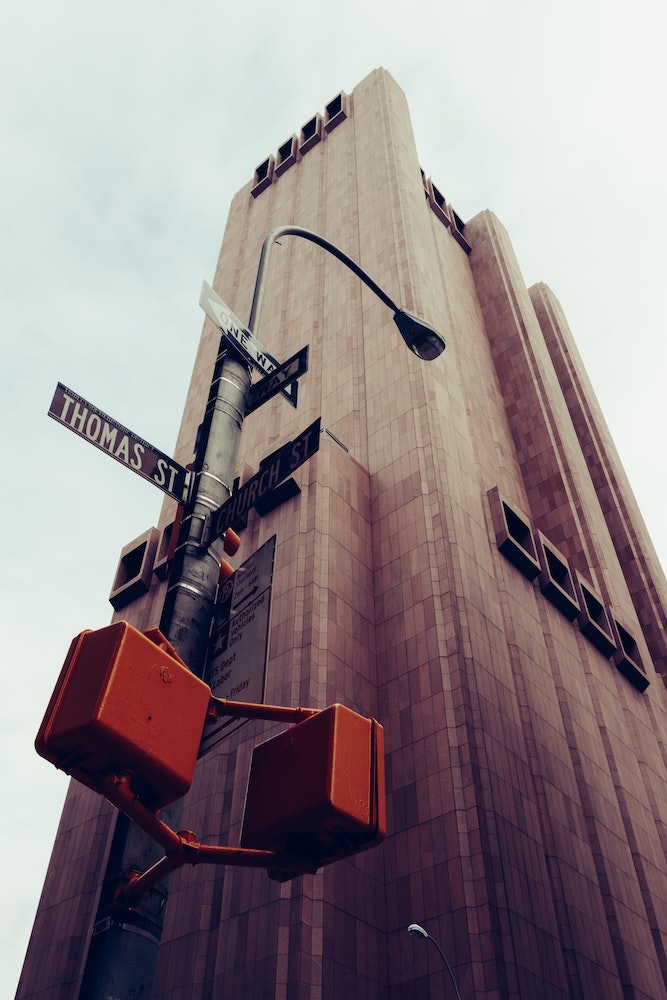Residents of the Tribeca neighborhood in Manhattan have long wondered at the building standing at 33 Thomas. With no windows, few doors, and a plethora of CCTV cameras- the structure has a mysterious aura, reaching up into the sky like a brutalistic sci-fi watchtower. While rumors have come and gone over the years, researchers and journalists have put together a number of clues as to what this building is really used for, and it’s darker than you might think.
The Long Lines Building
Described as one of the most secure buildings in America, 33 Thomas was built to house and protect American communications. Originally constructed for Bell System, the massive skyscraper was home to the Long Lines Department, used for telephone switching equipment. Drafted by architecture firm John Carl Warnecke & Associates, one of the largest architecture firms at the time, the tower was constructed in 1974 on Thomas and Church Street in Tribeca.
Bell needed ample space and high levels of security to support a bevy of long-distance and solid-state switching equipment. Because of this, many aspects of the design and layout of this building are unique and rare. Eventually, these assets would prove attractive to government intelligence services.
Rare Design Elements of the “Windowless Building” in NYC
A number of distinct features helped segue this skyscraper into a top-secret security hub. 33 Thomas is designed in the brutalist architectural style that focuses on materials and construction and is both windowless and fortified. Aiming to create a “20th-century fortress, with spears and arrows replaced by protons and neutrons laying quiet siege to an army of machines within,” the building is designed to withstand major threats and natural disasters, including nuclear blast or fallout.
Constructed during the tense times of the Cold War, the building has the capacity to support 1,500 people off-grid for up to a fortnight. There is enough gas, water, and generator energy to last up to two weeks after any type of external emergency.
The layout inside the building is different than some might imagine. Although it stands at 550-feet-tall, each floor is 18 feet tall, almost double the standard floor height of 10 feet for commercial buildings. The building contains 29 stories in total, with three basement levels. Floors are designed to support heavy loads, accommodating up to 300-pound-force-per-square-foot live loads.
Exterior walls are constructed with precast concrete panels made with flame-treated Swedish salmon pink granite. Protrusions in the building include air ducts, stairs, and elevators. Ventilation openings can be found on the 10th and 29th floors.

The wire center contained three major 4ESS switches for interexchange telephony- or long-distance calling- and several switches for competitive local exchange carrier services.
Bell System eventually became AT&T, and 33 Thomas changed from the Long Lines Department to AT&T Communications in 1984. Switches and other facilities were moved to the AT&T Long Lines headquarters at 32 Sixth Avenue around 1999.
33 Thomas still contains telephone switching equipment, but much of the space has been converted to high-security data center storage.
Catastrophe at 33 Thomas Street
The sturdiness of 33 Thomas has only been tested once. In 1991, a combination of human and equipment errors disabled the central switch office within the building. While attempting to switch electricity sources, scheduling conflicts led to delays in power checks. One plant was forced to go on battery backup, and eventually, power was interrupted.
More on CitySignal:
The fallout was heavy; more than 5 million calls were blocked, including Federal Aviation Administration private lines, leading to a disruption of air traffic control in 398 airports around the northeastern United States. This is the only documented time the building’s off-grid functionality has been tested.
The Intercept Report and Project X
Arguably the most fatal blow to the close-guarded secrecy of 33 Thomas came from the outside and through something physically non-threatening- a report by The Intercept.
The uncovering began in 2013 when whistleblower Edward Snowden revealed a number of documents concerning National Security Agency programs. Snowden provided jaw-dropping information illuminating how NSA surveillance programs run through “partnerships” with major US telecom and internet companies. The documents outlined how NSA equipment was integrated into AT&T’s network in New York City, and used to covertly monitor civilian communications around the country.
The exact location remained unknown until a couple of journalists, picking up where Snowden left off, went further to connect the dots. Henrik Moltke and Laura Poitras, two investigative journalists, became drawn to 33 Thomas, knowing it played a pivotal role in American communications.
“Everything about the building tells you not to go in there,” said Moltke, “There’s just a guard, but you can’t get anywhere further, there’s a thick bulletproof sliding door.” Laura Poitras remembered first looking into 33 Thomas: “All the kids in the neighborhood have myths about that building. It’s like a haunted house.” While some say it blends into the skyline, there is no way to miss its looming presence, especially if you live at residences like 93 Worth Street.

What came of their work were two major reveals: a documentary titled Project X and a report published through The Intercept. While Snowden’s documents do not explicitly cite 33 Thomas Street as the surveillance center, the building location can be surmised through architectural plans, public records, and former AT&T employee interviews. Independent investigation unearthed ties between local FBI buildings and NSA’s SKIDROWE satellite intelligence system. Finally, they had their target- right in the middle of Tribeca.
From AT&T to NSA Building in NYC
Despite being an architectural anomaly, the contents and use of the interior are not easy to verify as very few details are known and there is much speculation and the government and NSA have yet to publicly acknowledge anything.
If 33 Thomas, referred to as TITANPOINTE in government documents, is owned by AT&T, how did it become the operating grounds for covert monitoring projects? While much information has yet to be uncovered, interviews conducted with former AT&T employees combined with public records helped lead investigators to uncover some uncomfortable truths about 33 Thomas.
Top secret memos suggest NSA uses a secure facility within the building to tap through the “gateway switch,” the routing point for US and international calls. The surveillance program targeted communications of the United Nations, the International Monetary Fund, the World Bank, and of 38 countries, including Germany, Japan, and France.
NSA equipment was integrated into AT&T’s New York City network, becoming a part of American infrastructure and a means to monitor foreigners and Americans for national security threats. “This is yet more proof that our communications service providers have become, whether willingly or unwillingly, an arm of the surveillance state,” said Elizabeth Goitein, co-director of the liberty and national security program at the Brennan Center for Justice.

Secret NSA travel guides from 2011 and 2013 disclose TITANPOINTE is in New York City and is supervised by LITHIUM, NSA’s code name for AT&T. A block away from the FBI’s New York field office at Federal Plaza, NSA employees are advised to avoid wearing NSA badges or insignia while visiting TITANPOINTE.
The revealing tip that 33 Thomas was used by NSA came from documents tying TITANPOINTE to the government program SKIDROWE, a monitoring project focused on intercepting satellite communications. 33 Thomas is the only location in New York City where AT&T holds an FCC license for satellite earth stations.
33 Thomas As Seen Today
While nothing has been publicly verified by the government, many believe the speculations brought forth by Edward Snowden, The Intercept and Project X are close to the truth. The NSA has not responded when reached for comment.
In time, hopefully, we confirm the truth behind 33 Thomas. For now, it will remain as it always has- an alluring and windowless monolith in the Big Apple sky.
Lindsey Rae is a freelance writer, videographer, and medium format photographer with a background in economics, documentary filmmaking, and human rights. In past lives she covered the arts scene in Seattle and LA before morphing into a finance journalist, reporting from the NYSE for German news media. When not writing about culture & lifestyle she can be found studying herbalism and traditional healing techniques. She enjoys running, yoga, and world travel. You can find her at www.linerae.com or IG @hunteressthompson



